Ryzen 5 2400G, Ryzen 3 2200G APUs reviewed: Vega meets Zen - wordaboricand1983
Let's just lay our cards down at once. AMD's Ryzen 3 2200G and Ryzen 5 2400G Genus Apus are everything budget gamers have been praying for: surprisingly decent gaming performance at a shockingly low price.
In geezerhood past, such a statement would be met aside skepticism and dismissive "whatever" animated GIFs. But AMD really over-delivered connected its Ryzen CPUs past twelvemonth, so negotiation of combining those same Loony toons cores with the current and greatest Radeon Lope Felix de Vega Carpio graphics cores has cash-strapped gamers in a tizzy of excitement.
And it turns out the excitement is warranted. Compared to a likewise equipped Intel-supported system running a Core i3, the lower-end Ryzen 3 2200G is 142 percent faster in 3DMark Firestrike, 154 percent quicker in 3DMark Meter Espy, and 203 percent faster in Rainbow Sixer Siege. Those are just a few of the highlights from our game performance examination, which you rear reckon if you jump to our gaming tests.
In practical terms, AMD's new budget wonder chips should be able to produce a reasonable 60 FPS at 720p in many games, and some will be playable at 1080p, as well. And so if you've been avoiding building a play PC because of toss-heights GPU prices, these new AMD APUs provide some intriguing options—leastways on the budget end.
Now we'll dig into the Ryzen APU specs and architecture before we return to our performance results.
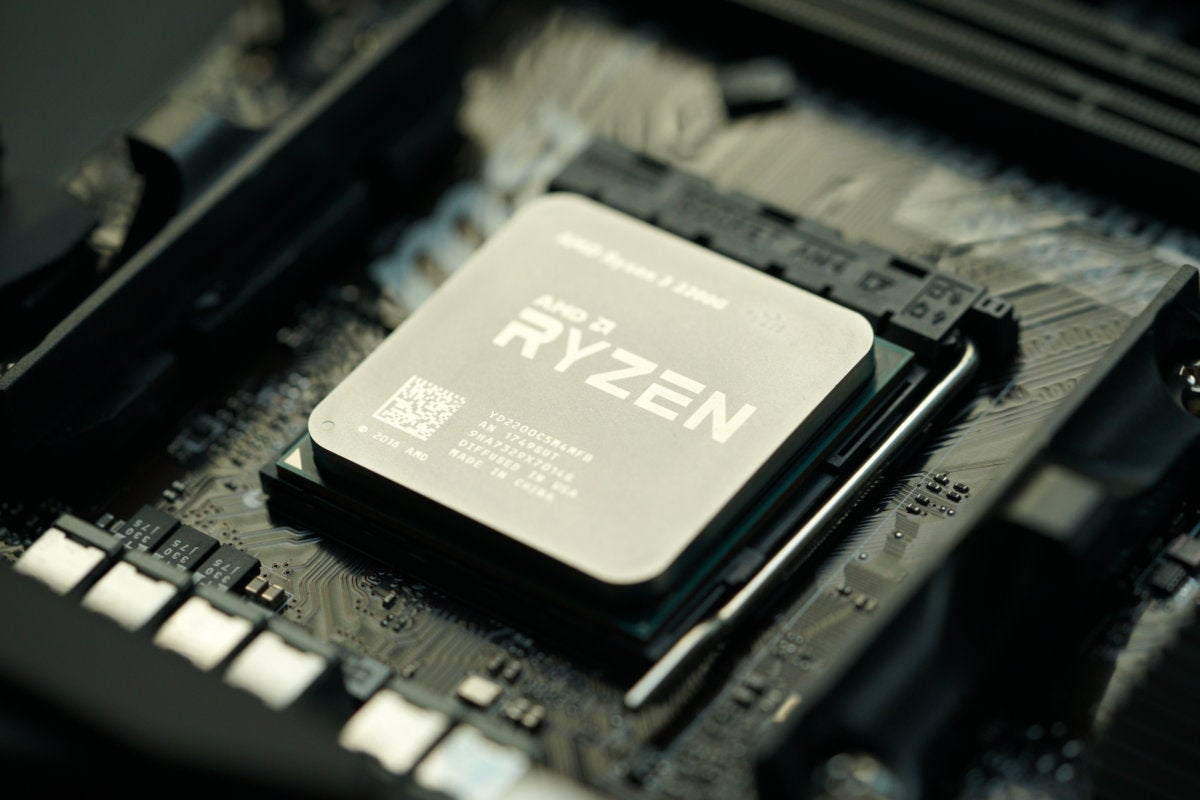 Gordon Mah Ung
Gordon Mah Ung For real: The $99 quad-core Ryzen 3 2200G offers graphics performance competitive with $99 art cards.
Ryzen 3 2200G and Ryzen 5 2400G specs
There are two Ryzen APU parts being released Monday. The Ryzen 3 2200G ($99 on Amazon) features four Zen cores without stellate multi-threading (SMT), which is AMD's version of Intel's Hyper-Threading. The cores consume a base clock of 3.5GHz with a supercharge clock of 3.7GHz.
For graphics, information technology features viii Vega compute units (CUs) inside. Yup, the same Lope Felix de Vega Carpio cores used in the company's impossible-to-obtain Radeon Vega cards (reviewed here).
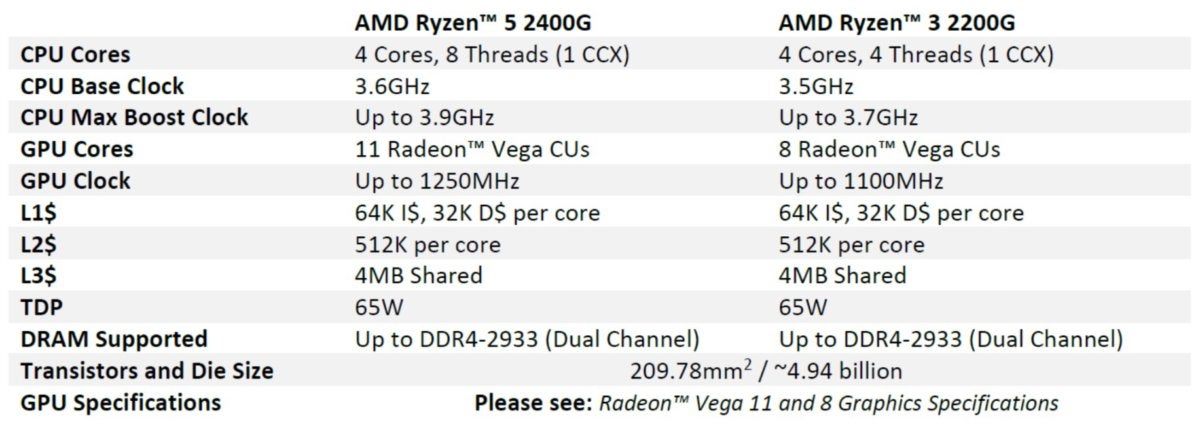 AMD
AMD One come forward is the Ryzen 5 2400G ($169 happening Amazon). It still nets you a quad-heart chip, but with SMT switched connected for a absolute of eight threads of computing power. AMD also increases the base clock to 3.6GHz and the boost clock to 3.9GHz. For graphics, you get around a fractional more than CUs, with 11 Vega units inwardly.
Both are AM4-based and should work in almost AM4 socket motherboards that have reveal outputs and the latest BIOS available. Unlike Intel, which locks its lower-end chips, AMD has left them unbolted for those who want to explore overclocking.
[ Further reading: AMD Ryzen motherboards explained: The crucial differences in every AM4 chipset ]
Ryzen APU vs. Ryzen CPU
Although the effective Zen cores are the same, the Ryzen APUs differ from Ryzen CPUs in a couple of key ways. In the chart above, three things should jump unsuccessful: less cache, half the GPU PCI lanes, and the use of a single, unified CCX in the APU, rather than the dual-CCX design in the current CPU.
All Ryzens are modular and built around the basic four-core CCX unit. An eight-core Ryzen 7, for instance, features two CCX units. Along the vi-core Ryzen 5 CPU, AMD disables a core on each CCX and links them together. Connected the 4-core group Ryzen 5 CPU, deuce cores are disabled connected each CCX.
This CCX data link has a real cost in latency (which technical school internet site PCper.com thoroughly explores here.) With its new APU, AMD said it needed to save space and make thermal way for the budget items of the Lope Felix de Vega Carpio cores, so information technology went with a single tetrad-essence CCX. This eliminates the response time issue, just also lowers total cache, American Samoa each of those CCX units has a dedicated cache.
AMD aforesaid the matter-of-fact bear upon in its own testing was minimal: Some games elate a little gain from lowering the latency, while others welfare slightly from the increased cache size. To help earn up for the cache decrease, AMD aforementioned, information technology buffs the clock speeds a bit.
 IDG
IDG There are some describe differences between AMD's Ryzen APUs and its Ryzen CPUs.
AMD didn't get into why it cut the PCIe lanes, only we'd guess it's referable the mobile roots of the APU. These Apus were designed to scale up from laptops to desktops and you just don't need every last of those lanes in laptops. Numerous tests over the years make shown PCIe lanes typically put on't impact GPU performance.
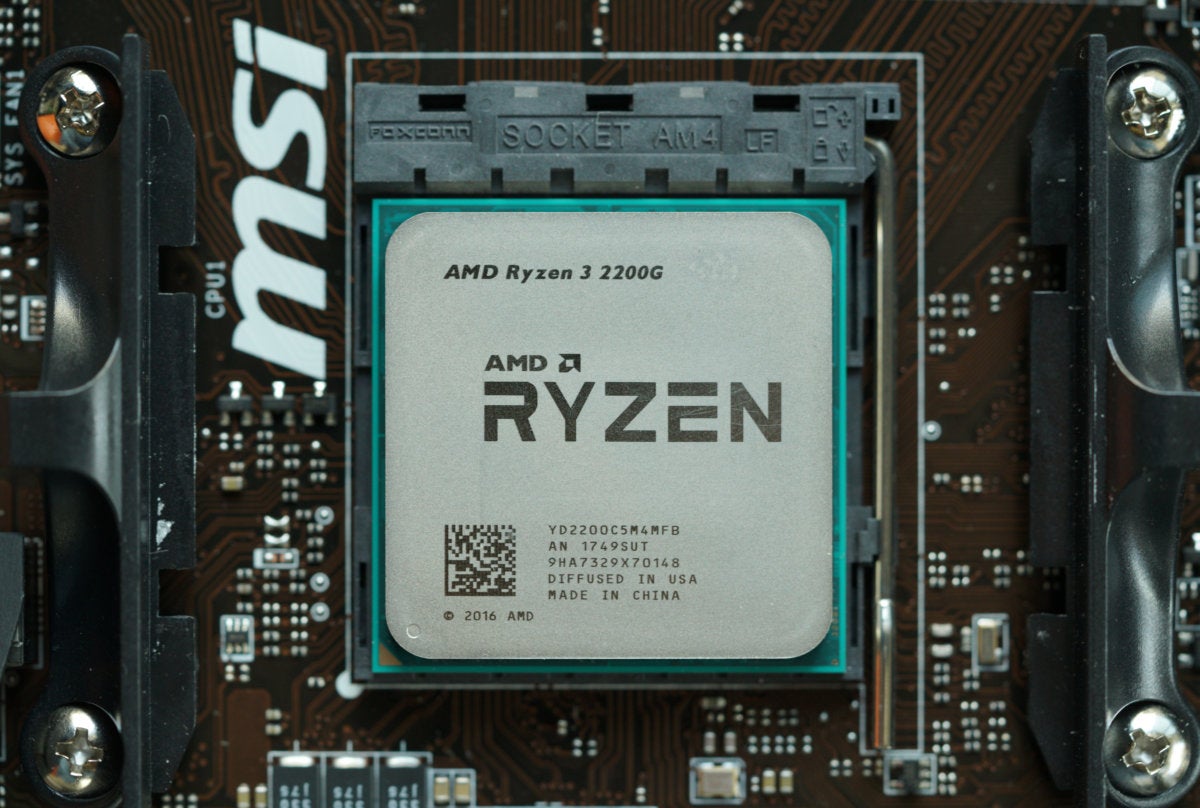 Gordon Mah Ung
Gordon Mah Ung We used an MSI B350 Pro AC motherboard and 16GB of G.Skill DDR4/3200 RAM.
AMD penny-pinches on the paste
One last divergency between the CPUs and the APUs is a shift from a auriferous solder thermal interface material (TIM) victimized in Ryzen CPUs to a paste-type material in the Ryzen APUs. AMD admits it did information technology to save bucks.
When the net learned Intel utilised a spread TIM in its Skylake-X chips, nerds went apoplectic at the thought of lowly paste in a functioning CPU. With the Ryzen APUs, I anticipate fewer rage. Even though the travel to spread will lower the APU's overclocking potential, these are budget parts, not $2,000 CPUs.
How we tested
For our performance test, we shapely on an AMD-supplied MSI B350 Pro AC motherboard and 16GB of G.Acquisition Flash DDR4/3200 RAM, approved and supplied by AMD. For storage we opted to use a 240GB Kingston HyperX Savage SATA SSD rather than an M.2 NVMe device, which would add to the cost and likely isn't the first choice of someone buying a $99 APU. All examination used the bundled AMD cooler.
For performance context, we decided to use an Intel Nub i3-7100 chip. It's a dual-core 7th-genesis Kaby Lake CPU with Hyper-Threading, and costs $115 along Amazon. It doesn't have TurboBoost, just its base clock is a goodish and constant 3.9GHz. For nontextual matter, it features Intel HD 630, which is used on everything from Core i7 to Core i3. We sourced this CPU from Amazon and used the stock cooler for our tests, along with a Gigabyte Tabun-H270M-DS3H MicroATX board.
If you're thinking we on purpose tried to make Intel look bad by non exploitation the similiarly priced 8th gen CORE i3-8100, we ass excuse our real reason in two words: motherboard costs.
With Kaby Lake, you can get an LGA1151 table for as cheap as $50 using H-series chipsets. Indeed far-off, Intel has not free a budget chipset for its 8th-gen CPUs, which means the cheapest Z370-dining table we could find was $120.
The graphics comparison should mostly be the same, as Intel's UHD 630 is essentially the homophonic as its HD 630. While the Core i3-8100 is a quad-core, its lack of Hyper-Threading and overall lower clock speed (there's none Turbo Boost) would probably put away the two very much closer in performance than you'd expect.
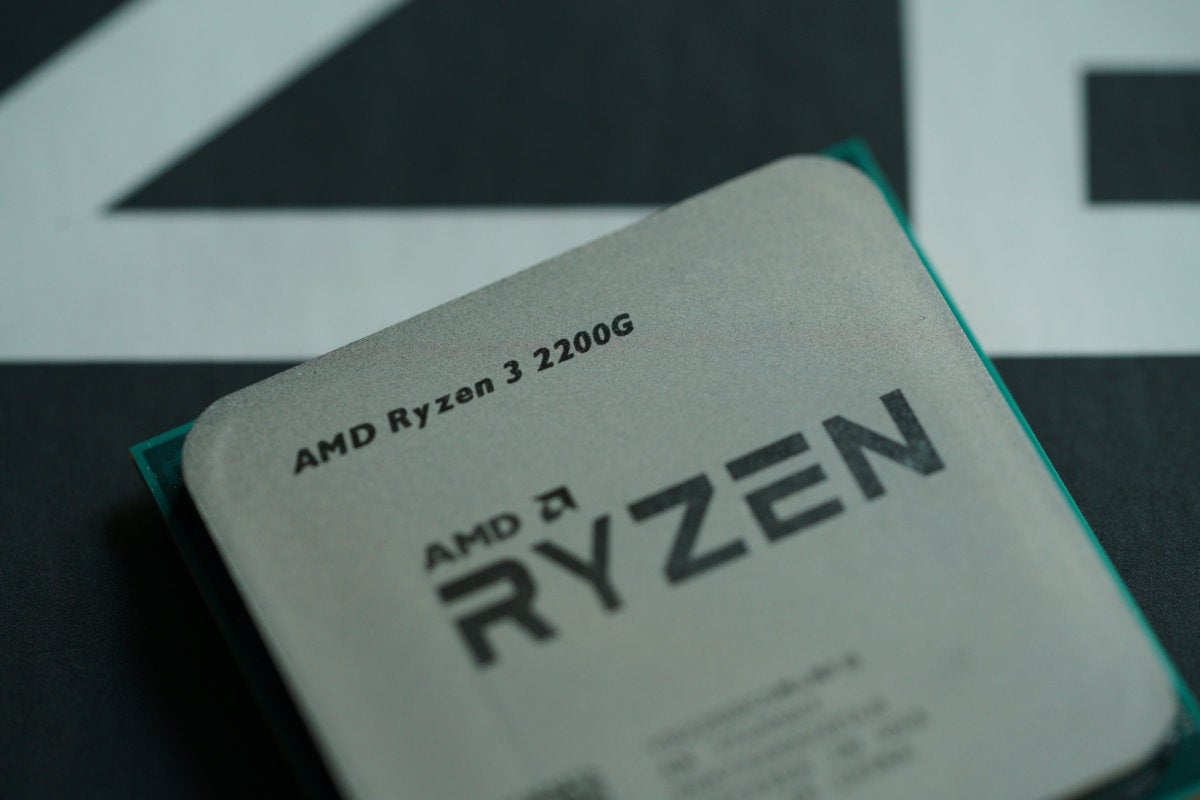 Gordon Mah Ung
Gordon Mah Ung Why we tested at DDR/2400
One last thing we want to notice: We misused 16GB of DDR4 on both platforms, some rated for DDR4/3200. However, the Core i3 would non run higher than DDR/2400 happening our H-series panel. That led us to ponder whether it was antitrust to test the AMD victimization higher-clocked RAM than the Intel board.
Ultimately we did test the AMD APUs at the higher speed as well as DDR/2400, but for our CPU section, we decided to present results at DDR4/2400 clock speeds. In our gaming section, because memory clock speeds are critical, we show multiple speeds. Because Ryzen does benefit from higher time speeds, you bum basically add about 5 to 6 percent to the performance of both APUs at higher clock speeds.
In conclusion, piece we had no issues run the Ryzen 3 2200G at DDR4/3200, the Ryzen 5 2400G was finicky with reboots occurring when using the preset XMP 3200 profiles. We suspect this is for the most part a tuning payof that testament eventually be worked out.
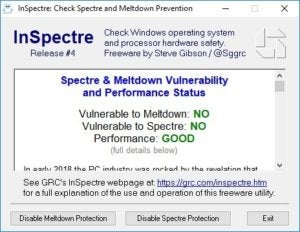 IDG
IDG We tested some Intel and AMD with whol of the purchasable Spectre and Meltdown patches in place.
Nuclear meltdown and Spectre performance
Whol our tests were completed with fresh installs of Windows 10 Fall Creators Update with the latest patches installed. And yes, that means we ran our tests with patches for the Nuclear meltdown and Wraith exploits in place. On the AMD platform, that means rightful OS updates. On the Intel chopine, that meant a microcode update every bit well. Although some vendors have yanked their Spectre microcode fixes, GB still offered information technology for the motherboard we used, so we installed it and verified IT with GRC's InSpectre.
3D rendering performance
Our first try is the venerable Cinebench R15.038 test. Based along Maxon's professional rendering engine, IT's pretty a great deal a pure CPU prove and scales recovered with thread and effect count.
The result is none surprise: The musculus quadriceps femoris-core $99 Ryzen 3 2200G easily outstrips the $116 Core i3 away 42 percent. Going from the Ryzen 3 2200G to the Ryzen 5 2400G, we ascertain about a 35-per centum bump past adding SMT support.
 IDG
IDG The quad-cores chips easily rule over the dual-core Intel in the multi-threaded Cinebench R15 test.
Not everything is multi-threaded, though, so we also run Cinebench R15 using a respective compute thread. Here's one test where the Core i3 ekes out a win.
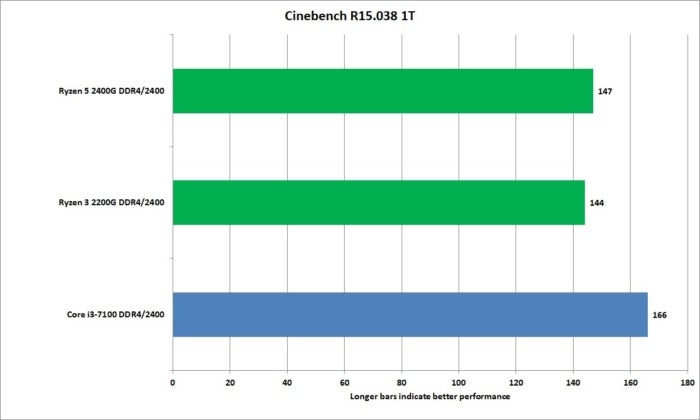 IDG
IDG In Cinebench R15's single-rib test, you can see the slight clock-bucket along and IPC reward that Intel's Core i3 has. Higher-clocked RAM helps the Ryzens, but if the RAM is the same, Intel is leading.
Should you be surprised? Not rattling. Intel's advantage in IPC (instructions per time) efficiency is real. When combined with its regular 3.9GHz clock speed, IT's a fantastic chip for single-threaded tasks. In fact, for uses outside of play, it's a fine CPU.
Encoding performance
Our next test uses the free and popular HandBrake encoder to convert a 1080p high-bit-rate file using the Android Tablet predetermined. HandBrake, like most video editing and encoding applications, loves CPU threads, and the Ryzen APUs walk gone from the dual-core Core i3. We suspect the Core i3-8100 would personify very militant here with the Ryzen 3 2200G, but once more—it's another $70 out of your pocket to guide that Coffee Lake CPU.
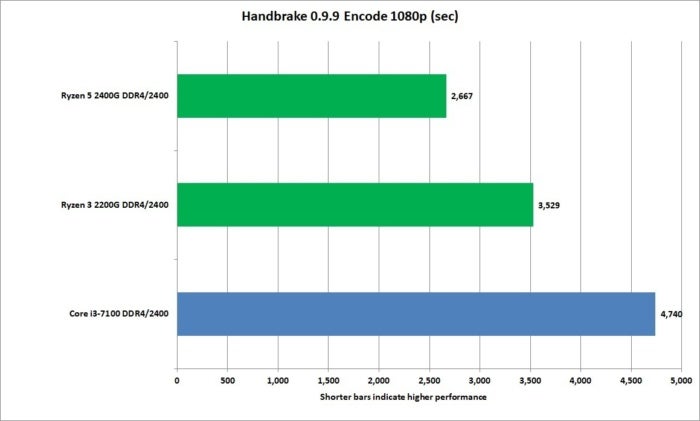 IDG
IDG If you do encoding, you'll want the higher threads such as in the Ryzen APUs
Compression performance
Our next test uses the costless 7-Zip utility and its stacked-in performance bench mark. The try is a CPU test and doesn't look at the saucer I/O atomic number 3 a cistron. AMD again leads the way, with the dual-core Core i3 landing where we expect.
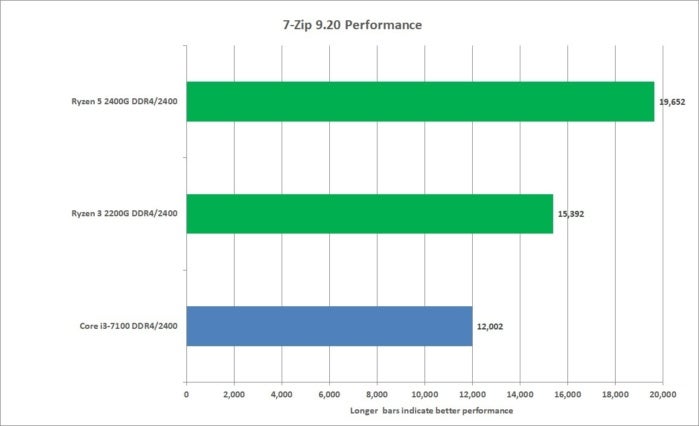 IDG
IDG The 7-Zip condensation/decompressing test puts the Core i3 within striking distance of the Ryzen 3 2200G, but once you hyperkinetic syndrome SMT to the Ryzen 5 2400G, AMD is clearly ahead.
Ryzen APU gaming public presentation
Instantly we know AMD gives you more cores or more threads than Intel for the money, only Intel's cores are also generally better. Let's see how that plays call at games.
3DMark Sky Diver is fairly lightweight—basically like playing a typical eSports game—and thus a useful tool for measuring, suppose, integrated graphics. Rather than use the gross score, which factors in CPU performance, we're drilling down into the artwork subscore. The musical score you see for the HD 630 should constitute fellow, as IT's what most IGP-based Intel laptops get coughed upbound for the death year Beaver State two. With the Ryzen 3 2200G and its Vega 8, you're looking at more a 133 percent increase in performance compared to Intel's Core i3. The Ryzen 5 2400G takes that to 178 percent. Let's articulate that again, but slowly: 133 pct and 178 percent.
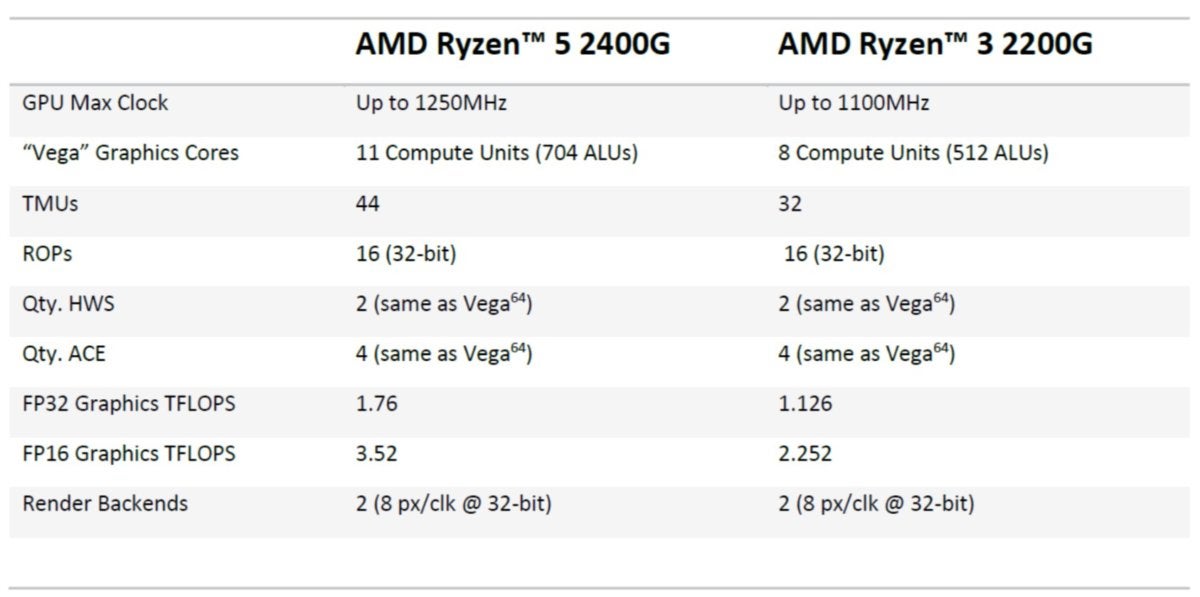 AMD
AMD Detailed specs of the graphics cores in the new Ryzen APUs with Vega graphics. For comparison, a Radeon RX 580 offers 6.1TFLOPS of performance.
The thing is, on desktop chips, it rattling doesn't grow any better for Intel. Its Iris Plus lineup of graphics with EDRAM International Relations and Security Network't purchasable in a socket. And mind you, this ISN't even method of accounting for the speed advantage of using higher-clocked Chock up in Ryzen.
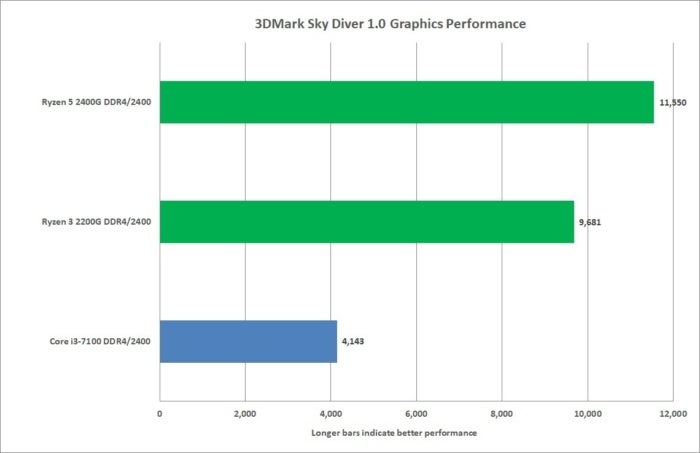 IDG
IDG The lightweight Sky Frogman test shows the limitations of Intel's HD graphics over the Vega cores in the Ryzen APUs.
Ryzen APU performance in 3DMark FireStrike
Let's step busy something a dwarfish harder: 3DMark Fire Strike. It's obvious Intel's HD 630 isn't busy the project, so we pulled numbers from a Ryzen 5 1600 scheme with a Radeon RX 550 2GB card in it. This Polaris-based GPU can be plant everywhere from $110 to $150. The tests we selected are largely GPU bound, so the axiomatic increase in core count on the Ryzen 5 1600 should have minimal impact.
I'm also going to rope in public presentation results for the Ryzen Genus Apus with faster RAM. As a admonisher, I used DDR4/2933 oodles for our Ryzen 5 2400G, because it wasn't quite a stable at DDR4/3200 with the G.Acquisition modules AMD provided.
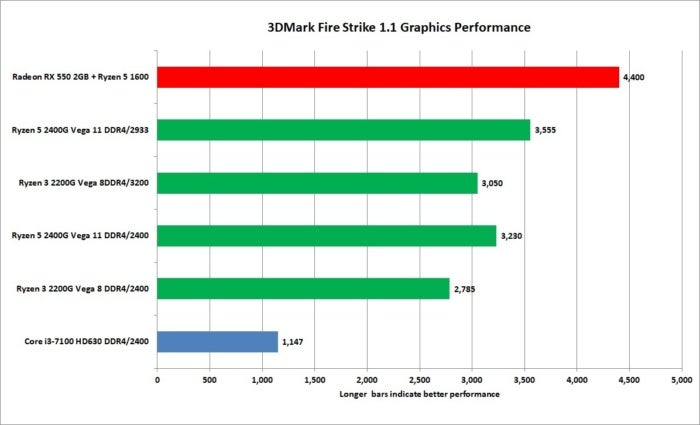 IDG
IDG While the Radeon RX 550 leads the way, it's herculean to say that difference of opinion is worth $110 to $150.
The results speak for themselves. The Radeon RX 550 clearly has a lead, simply those APUs approximate. Information technology's rattling hard to justify a $110 to $150 premium for that difference. Putting that money into a bigger SSD or Sir Thomas More RAM—or socking it away until you have enough for an RX 570—makes very much Thomas More sense.
Ryzen APU performance in 3DMark Time Spy
Our antepenultimate 3DMark exam for straightaway is Time Undercover agent. It's a test built all to examination DirectX 12 gaming performance. Interestingly, the lead the Radeon RX 550 had in the DX11 Fire Strike test evaporates, and surprise, the Ryzen 5 2400G is isoclinic to it when running higher-clocked computer memory.
The Ryzen 3 2200G also represents well and for the money, it's cooking along nicely—specially when compared to Intel HD 630 graphics.
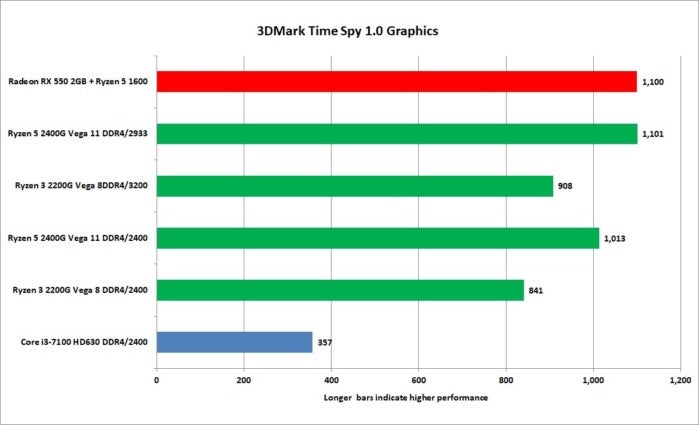 IDG
IDG In the DirectX 12-focused Time Spy test, the Ryzen 5 2400G pulls unanimated even with a $110-$150 GPU!
Ryzen APU performance in Rainbow Sextet Siege
Now let's take care how the Ryzen APU handles literal games. Our kickoff test is the circa-2015 Uncle Tom Clancy Rainbow Six Siege. We tested IT at multiple resolutions and game quality settings, but they're pretty much completely effectual. We see the Ryzen APUs actually pulling dead-even with Radeon RX 550—and then surpass it when paired with higher-clocked Random-access memory.
The Ryzen APUs almost own decent grit to plow Rainbow Six Siege at 1920×1080. The Ryzen 5 2400G pushes 51fps, and the Ryzen 3 2200G, 40fps.
The Intel HD630 graphics? Let's just quit talking about it, okay? At a certain point in time, information technology just becomes cruel and inhumane.
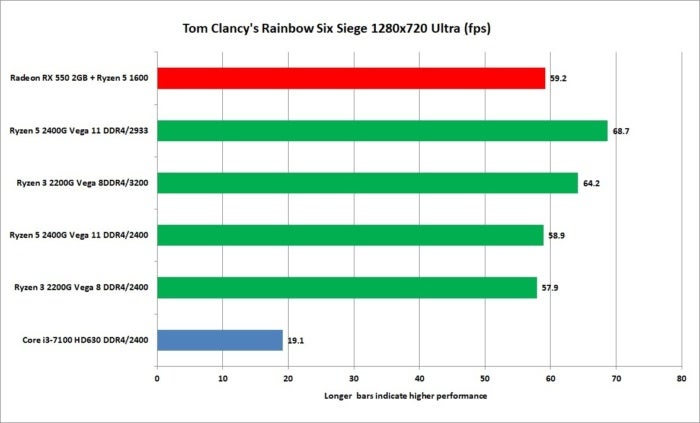 IDG
IDG IT's not a mistake: We saw higher performance out of integrated graphics than a GPU.
Ryzen APU performance in Rise of the Tomb Freeboote
Even though it was also released in 2015, Rise of the Tomb Raider is a far harsher graphics load. Rainbow Six Military blockade is playable at 1920×1080. RoTR ISN't.
Total, we saw decent performance from the APUs, especially when paired with quicker system Cram, but they're still really "but" 720p-moderate-capable. Simultaneously, even the Radeon RX 550 was only 5fps faster than the Ryzen 5 2400G.
The takeaway here is that if you'atomic number 75 expecting to get by with 1920×1080 gambling all the clock time, you'ray going to be disappointed in some heavier titles.
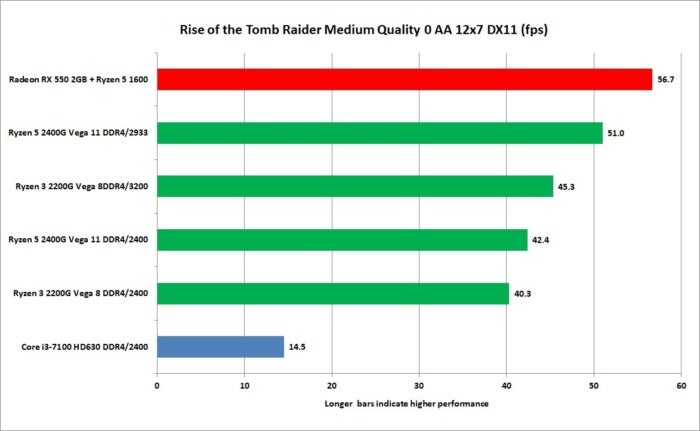 IDG
IDG It may be from 2015, but Arise of the Tomb Freeboote is much for budget parts to chew on.
Can the Ryzen APU run Crysis?
By now, you probably want to make a wisecrack: "Can it rill Crysis?"
This statement refers to how the 2007-vintage game brought even the most powerful and expensive gaming rigs to their knees, begging for mercy. More a decade after it unmoving represents the most final bad-ass game of all time (at to the lowest degree until everyone learns to whine that whatever game they didn't like was "poorly optimized.")
Well, guess what? The new Ryzen Genus Apus potty run Crysis. Using the ancient single-player demo, we ran the island GPU demo file and taped the average Federal Protective Service of each completion (it doesn't seem to wishing to spit up a terminal score anymore).
To give you a find for how removed we've come, we also dug up a performance paper that Ryan Shrout at PCPer.com recorded in 2007 lengthwise the Crysis demonstrate on a GeForce GTX 8800 GTX. Shrout's score was generated at a slightly higher resolution of 1650×1200, but IT's clear-thinking the the Ryzen APU is quicker in Crysis.
Granted, there is a world of difference in in operation system, drivers, and computer hardware, but the clear-of-the-strain $650 GPU was simply hobbled by Crysis. Even worse? That Intel HD 630 really International Relations and Security Network't that far behind the GeForce 8800 GTX. IGPs own come a long way.
 IDG
IDG Yes, it can course Crysis. As a matter of fact, it john run it better than a $650 GeForce 8800 GTX card too. Of course, that card is over a decade old, but Ryzen is integrated graphics.
How much does memory interest a Ryzen APU?
If you've been stipendiary ungenerous attention to our graphics results, you've noticed that quicker Random access memory helps. A lot. Unlike a GPU that has its own pool of very fast RAM nigh, the IGP uses the RAM in the PC itself. To see how a good deal of an impact various time speeds of Aries matter with the Ryzen APU, we canned performance gains from 2,133MHz to 3,200MHz RAM on the Ryzen 3 2200G. We also tape-recorded how a good deal of a smash you take by functional single-television channel mode vs. dual-channel.
We used 3DMark's Fire Strike Graphics test, which is isolated to graphics performance.
 IDG
IDG Retentiveness matters with any IGP and especially with Ryzen Apus.
The results show how every notch up in memory travel rapidly takes you up in performance. Going from DDR4/2400 to DDR4/3200 nets you astir 9.5 percent more performance. Is IT worth it? That very much depends on how much you're paying for the high-speed RAM.
On the solar day we wrote this, we could find 8GB of Corsair Retribution DDR4/2133 for $102. The cost for 8GB of Corsair Vengeance DDR4/3200 ran $115. That means you'd be paying about 13 per centum more for RAM for about a 9.5-percent addition in performance. We'd plausibly say it's worthy it, especially if you can get the price a smallish closer. The cookie-cutter day, we also found the same DDR4/3200 modules on sales event for $109, which meant stipendiary about 6 pct Sir Thomas More for about 9.5 percent more performance.
One thing we can for certain pronounce is, don't cheap out and buy a unmated faculty. As you can see from our results, doing so would kneecap your nontextual matter performance.
 IDG
IDG Proof: AMD's new Ryzen 3 and Ryzen 5 with Vega art are simply the quickest graphics ever introduced in a socketed processor.
Conclusion
We've tested plenty of CPUs with integrated nontextual matter, but with all of them, we've had to issue Sir Thomas More disclaimers than a pharmaceutical ad. AMD's new Ryzen Genus Apus are simply the first gear processors with graphics to get everything right.
With the new Ryzen APUs and their Lope Felix de Vega Carpio cores you'atomic number 75 finally getting the right way graphics performance with big top-ledge x86 cores at a terms that International Relations and Security Network't a gag line. Frankly, it's amazing timing for AMD to come out with a bit that rump help snuff out budget gamers' thirst when thither's a drought of GPUs.
We've understand comments that people think the Ryzen Genus Apus will "save PC play." While we think that's going also far, we have to admit, at least there's finally a decent option for budget gamers.
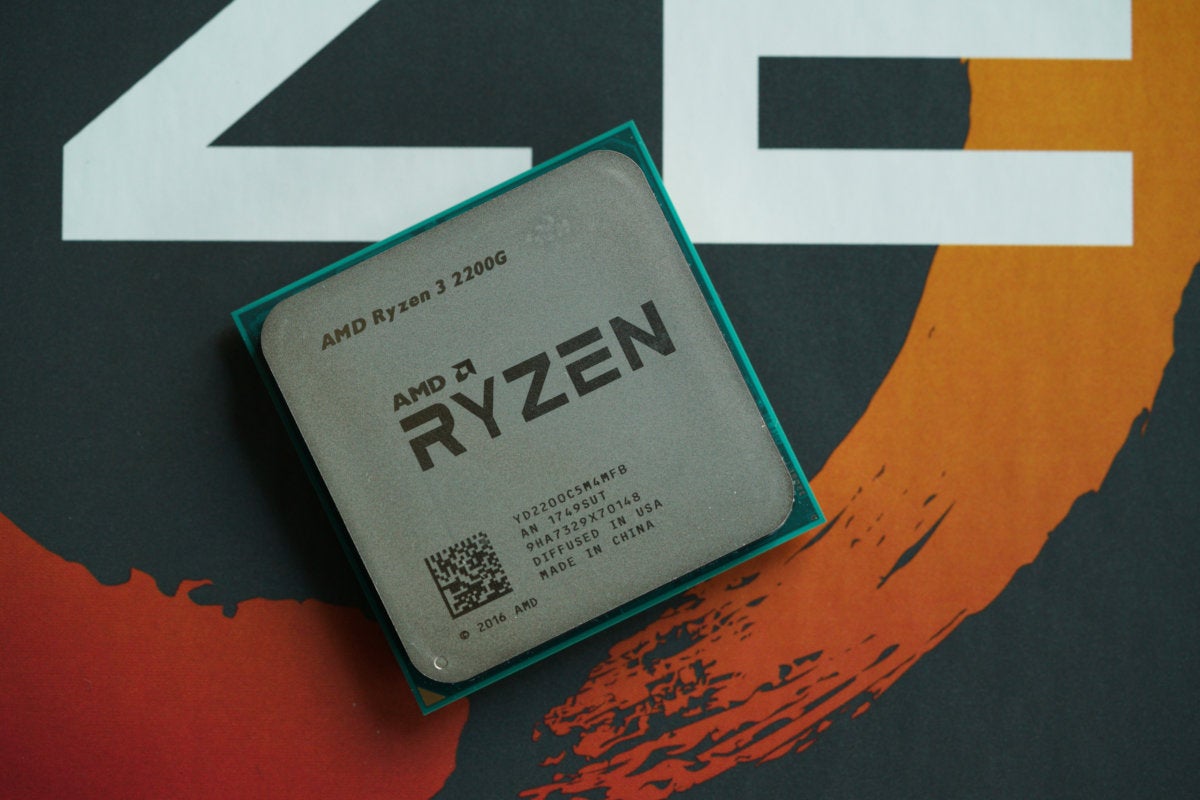 Gordon Mah Ung
Gordon Mah Ung Source: https://www.pcworld.com/article/407911/ryzen-apu-review-ryzen-plus-vega-saves-budget-gamers.html
Posted by: wordaboricand1983.blogspot.com


0 Response to "Ryzen 5 2400G, Ryzen 3 2200G APUs reviewed: Vega meets Zen - wordaboricand1983"
Post a Comment